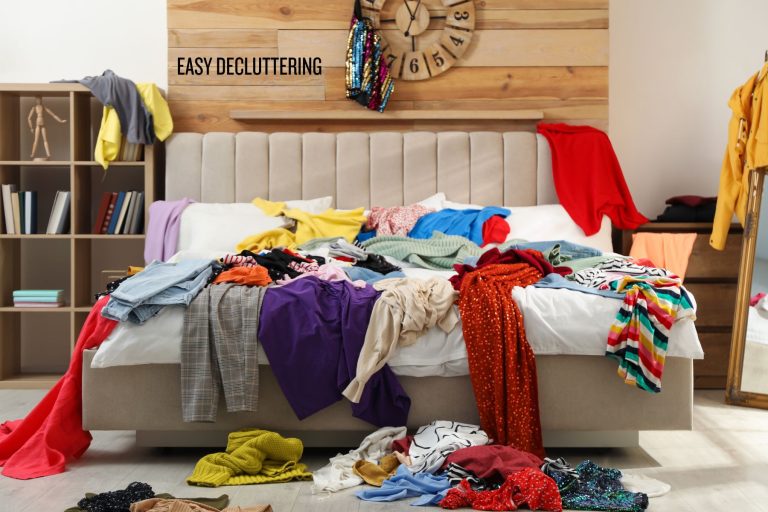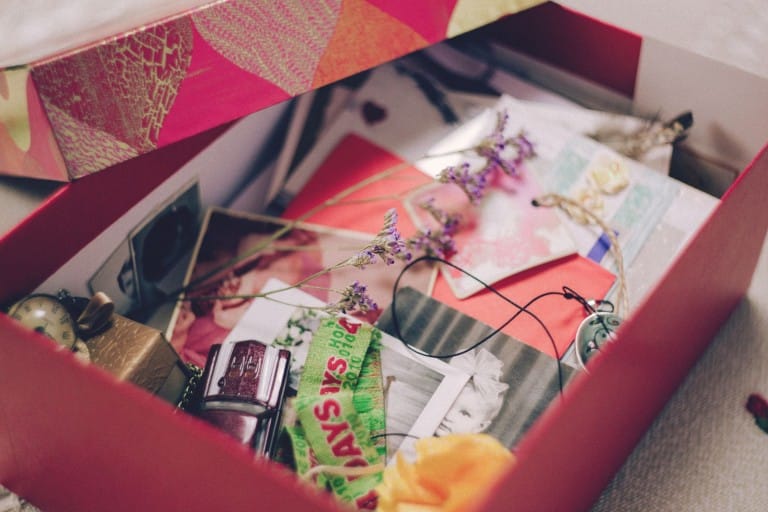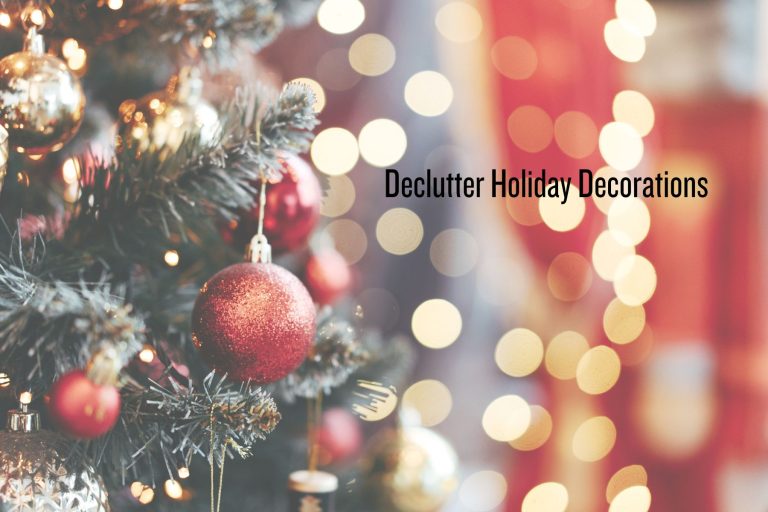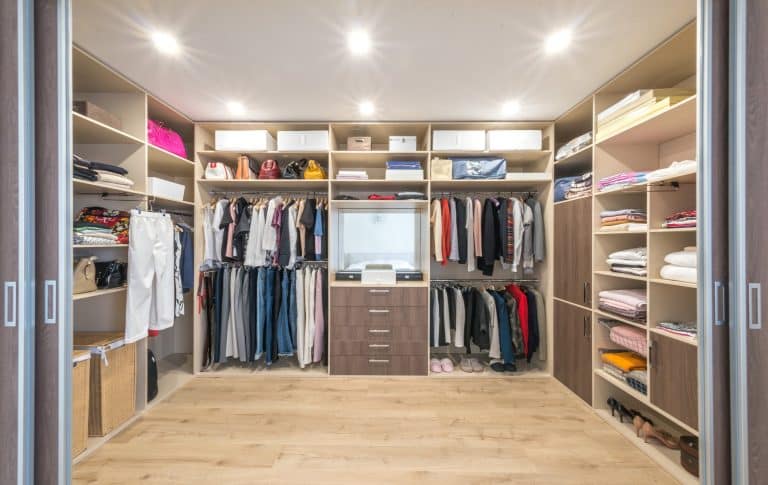Tame The Madness: Sentimental Decluttering
As an Amazon Associate and member of other affiliate programs, I earn from qualifying purchases.
It’s the most sentimental time of year, when ghosts of holidays past remind us of loved ones who have left us, children who have grown and flown and our own childhood memories; a Pandora’s Box of sentiment for many people. And speaking of boxes, sentiment is a big reason things make their way into boxes in the first place, it is a primary root cause of clutter because it feels so hard to let something go that means something to you (or someone in your family.) Clutter takes up physical space in our homes and mental space in our brains and feels like a more frightening thing to tackle as the years go by. Breaking free of that clutter and the cycle that perpetuates it can be so rewarding – let’s talk about the best way to approach it!
I’m a sentimental person who is also organized. I do keep things around because I like to re-live memories every once in a while, such as reading old journals, letters from friends and family, and my favorite books that I like to read over and over again. In my research for this post I wanted to understand why getting rid of sentimental clutter is so hard for so many people, including me. I learned that the Ventromedial Prefrontal Cortex is the part of the brain where sentimental activity happens; the home of ‘want power’ and sense of self. It’s also the region of the brain associated with conflict and pain. What is happening when you are literally feeling pain attempting to let go of something is your VPFG looking for an opportunity to prevent harm or relieve anxiety; in this case keeping that thing that is mentally connected to your sense of self. Having some awareness of your brain’s habits and inner workings is the first step to attacking a decluttering project rooted in the sentimental. As in most cases self-awareness is half the battle and you can practice ‘over-riding’ your VPFC circuitry and breaking free of the cycle. The other half of the battle can be won using some key filters as you embark on your decluttering journey.
What is the signifigance?
What is it about that item that makes you feel the connection to it? If it is something that brings back a specific (happy) memory that you would like to re-visit then it could be a candidate to keep. If you can’t remember why you kept it or it does bring up a memory that is not joyful then ditch it. Items of positive significance should go into a pool of potential items to stay (key word here is potential, we actually aren’t finished with them yet so stay tuned.)
Can you use it or display it?
And do you want to? I play a game with myself: if there is something I want to keep because it reminds me of a happy memory then I should be able to find someplace to display it. If it is not worthy of display or I can’t otherwise make room for it then it has to go. (I will tell you a fun story about a soccer trophy in a minute, hold please.) Functional, useful items should have a leg up in the decluttering process, sometimes that means replacing something you already have. For instance, replace the unremarkable carving set you bought out of necessity with the set you inherited from your parents that reminds you of your dad carving the turkey every year (Thanksgiving on the brain!) If the items is actually useful and you actually use it you will get so much more out of keeping it, items stashed away in boxes or storage units aren’t working for anyone. If you won’t use it – toss it!
Are you keeping it out of obligation?
This seems to be a particularly pernicious category that applies to a lot of stuff for a lot of people. ‘But so-and-so gave it to me!’ is the common refrain. If the item itself holds no significance for you, you don’t plan to display it and you won’t use it then let it go. I promise that you won’t regret this decision. If the worst comes to pass and the person who gave it to you asks about it, you can always employ the little-white-lie strategy (you lent it out/it’s getting fixed/a small child broke it.) The feelings of guilt that you fear will most likely last for maybe 24 hours tops, the freedom and feeling of lightness will be far greater!
Save the best – toss the rest
This filter applies to any kind of collection (yours, a relative’s, your child’s.) Remember that item of significance that is waiting patiently in the potential-items-to-keep pile? If that item is one of many (e.g. a collection of shells you saved from a beach vacation in Nantucket when you were 12) my suggestion is to keep one, not the whole collection. If you are keeping something because it reminds you of a favorite grandparent, great. If you are keeping 50 things (that you aren’t using or displaying) because they remind you of said grandparent then consider editing down to your few favorites. Think of yourself as the curator of a very very small museum with lots of other artists (or in this case relatives + your own stuff) – which are the items from that collection that bring you the most joy? Keep those and let the rest go.
So those are the filters you should use as you approach each item. Now for the big hairy categories that most folks have in their homes:
-
Your kids’ sentimental stuff
-
Your sentimental stuff (& maybe a spouse’s)
-
Your parents’ or other relative’s sentimental stuff
ACK! Potentially 3 generations worth of sentiment-laden artifacts! As I advise with every task/project/endeavor that feels overwhelming: take it in small chunks, folks.
KIDS stuff
The three bugaboos of sentimental kid clutter are Art, Clothes and Toys. Why is it SO HARD to edit your little people’s hundreds of drawings, collages, paintings and sculpture? I was fairly ruthless in this regard when the kids were small but I will say I did feel like a heartless parent as I tossed the art in the recycle bin along with the million other papers that came home in their backpacks. I did keep some things and pretty much followed the filters above. Did the art have significance? A super-cute self portrait for instance; my son drew one in which each of his teeth were individually drawn in some detail. Would I display it or use it? Only one of my 3 kiddos was artistically inclined, I did hang some pieces that my daughters made at a (high-quality) art camp they attended. Not only do those pieces remind me of them but they are really nice to look at and still hang on the walls today. I also kept the ceramic little bowls that 2 of kids made in the first grade. I have used them as salt cellars for years – super functional! I just recently when back through the bin that houses the rest of the art that I saved from all 3 kids (notice I was a pretty good editor but still ended up keeping a decent amount of school art!) I ended up ditching most of it but did keep their journals, which are like little time capsules full of their insights on daily life, their friends, siblings, favorite vacations and many miss-spelled words. Those journals are gold and I love to go back through them – meanwhile the elephant outline plastered with tissue squares and finger-painted grass didn’t give me the same feeling so it went in the bin. Another strategy to employ is taking photos of the art, which is a good compromise but also adds to your photo clutter so be aware if you do this! I still advocate for tossing the majority and if you are tossing now, it’s okay – you aren’t a bad parent, ask your grown children they will back me up. Get in there, save the best and toss the rest!
People don’t seem to have as hard of a time editing clothing and toys as they do with art but these can also be formidable editing projects. I have saved a few precious pieces of clothing (the coming-home-from-the-hospital onesies plus my favorites of my daughters’ Lilly Pulitzer sheath dresses) – enough to fit in one smallish bin. However, I have many friends and clients who have saved way more in the clothing department. What exactly is the plan for these pieces? My best friend saved many clothing items as her 3 daughters grew up. She was intentional in picking out significant pieces; things they wore a lot that would be remembered, dresses from special occasions, etc. Then she found someone on Etsy who makes personalized quilts and is gifting one to each daughter at their HS graduation. She was keeping the clothing with this idea in mind the whole time but you could also use the idea if you randomly kept a lot of your kids clothes and are having a hard time parting with it. Toys were really easy for me to edit, I did the rounds about twice a year prior to birthdays and Christmas and brought a big load to Goodwill to make room for the new stuff coming in. I involved the kids in the process so they learned about purging and making space in their rooms for the things that mattered to them. I did save a few ‘classic’ toys, games and books (actually I saved most of the children’s books.) I plan to bring those out again when grandchildren (hopefully) arrive on the scene someday. For instance, I saved our entire collection of Thomas the Train tracks, several wooden puzzles and one large bin of Legos.) The books are classics; some will stay at our house but the bulk I will curate as gifts to the (eventual) grandchildren. If there are toys you think should go but your kids want to keep just give it a few years and press them again, mine usually gave in as time went by.
your stuff
As you move along the generational line, you should be getting the hang of this de-cluttering thing. Your stuff should be the least painful because there are no feelings of guilt or obligation attached to say, the papers you wrote in High School or College. Or your sports memorabilia. Or the many many birthday cards you received over the years. Pass your sentimental items through our filters. Only save the things that truly bring you joy and that you find yourself re-visiting often over the years. I have a good example that I came across recently. I used to have saved all of my childhood soccer trophies (received back in the old days when you only got a trophy for actually winning something.) Over the years I got rid of most of them but one remained. It was from 1981, when my AYSO team won the Regional Championship. My dad was the coach, our team was amazing, some of my best friends were on the team with me, it was awesome. I got sick the weekend of the regional tournament and my dad (who was a pediatrician) put me in the game with a 104 degree fever because ‘we really need you Carrie’ (my mom, who happened to be out of town that weekend was not pleased when she found out.) So many great memories tied up in this trophy! But I found it in the back of a cabinet in our laundry room because who proudly displays a childhood soccer trophy in their home? Well, I insisted (to myself) that if I was going to keep it, I had to display it and decided that my office was the appropriate place. The trophy has a heavy base and is good to use as a bookend. However, the bookshelf in my office was pretty crowded with books, if I wanted to display the trophy there I would need to make some room. Well as it turns out my High School yearbooks were on that bookshelf. They are heavy, take up a lot of space and I never look at them. I have a lot of photos from High School, I look at those a fair amount, but the yearbooks? Not so much. It felt weird at first to get rid of the yearbooks that I had saved for 30+ years but honestly, I haven’t missed them a bit. And my trophy makes me smile every time I look at it!
Your parents’ stuff
It is likely that you have inherited things from your parents, whether or not they are still living. Donating or tossing things you have received from loved ones can be the most difficult category to attack in your decluttering project. Our same filters apply but the one that feels the most important here is Save the Best – Toss the Rest. This is just a cute way of saying you don’t need to save everything your (mother/father/aunt/uncle/grandparent) gave you – pick the few favorites that bring you the most joy or that you will use or display and let the rest go. If you just can’t bring yourself to pull the trigger, separate those things into boxes and put them away, out of sight. Then come back in a month (or 6) and revisit. If you have been working on a decluttering project then you are likely building up editing muscle that you didn’t have before. If you wait a bit and come back you will likely be ready to take that last step toward freedom!
Another thing to consider on your journey is that your relationship to sentimental items will likely evolve over time. Things that you were attached to in your 20s might not mean as much in your 40s or 50s. Don’t just put something in the ‘save’ category simply because you have been saving it for years. Put that item through the filters, you may find that it doesn’t hold the same significance it once did, and that’s okay!
One last piece of advice for anyone de-cluttering: because the work of editing down sentimental things can be really emotionally-draining it is wise to tackle the project in smaller pieces vs all at once. Give yourself some time to re-charge between sessions, it will take longer but you’ll be more effective and build your editing skills as you go. Taming the sentimental madness is not a project for the faint-of-heart but you will feel so much lighter and happier when you are done! Good luck!






